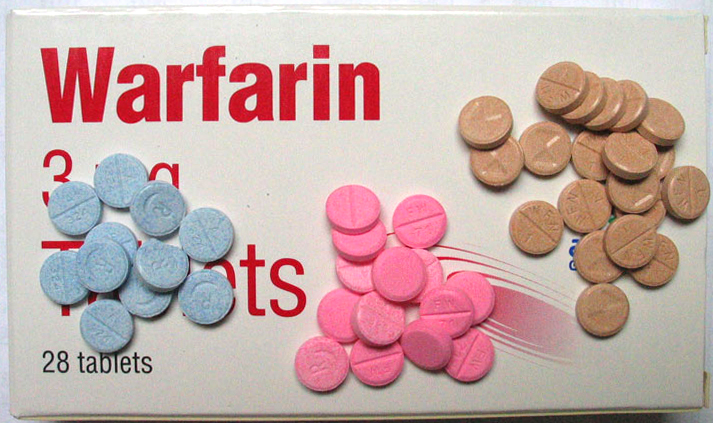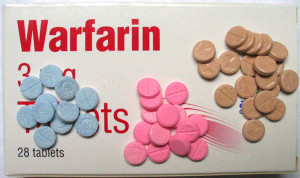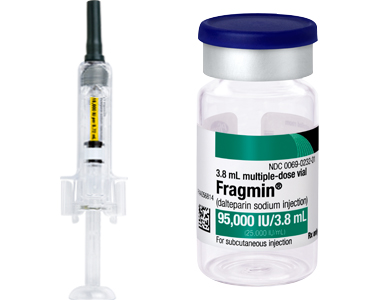Patients with atrial fibrillation are often treated with anticoagulants such as warfarin (Coumadin) to prevent stroke. When undergoing endoscopic procedures such as upper endoscopy or colonoscopy, anticoagulant drugs are usually held several days in advance to allow the blood thinning effects to dissipate. This way, if interventions need to happen during the procedure, such as biopsy, polypectomy, or dilation, the risk of bleeding is lessened.
Sometimes it is recommended to “bridge” the patient with another anticoagulant for those few days that Coumadin is held. The theory is that by holding the anticoagulant the risk of stroke increases, and this risk might be further increased by the stress of surgery on the body. Therefore, patients are often given an injectable anticoagulant such as enoxaparin (Lovenox) or dalteparin (Fragmin); this takes effect immediately and protects against strokes for the few days the Coumadin is held before the procedure, and for the few days after Coumadin is restarted but before the levels are therapeutic.
But is this common practice of bridging from Coumadin to an injectable anticoagulant back to Coumadin necessary? From a practical point, it is usually a major inconvenience for patients and doctors alike. Many patients are uncomfortable giving themselves injections at home. The injectable anticoagulants are sometimes expensive. Sometimes despite good instruction, they are administered incorrectly by the patient, or on the wrong dates. What if Coumadin was just held and later restarted without the bridging?
To answer this question, investigators did just that: A randomized, double-blinded, placebo-controlled noninferiority trial of bridging versus not bridging (appropriately named the “BRIDGE” trial) was just published this week in the New England Journal of Medicine. A noninferiority trial is designed to show that one intervention is “non inferior” to another intervention. This is different from most trials that try to show Drug A is better than Drug B. Noninferiority trials assign a predetermined number to how much better or worse Drug A has to be when compared to Drug B to consider them no different. For example, if Drug A cures disease X in 50% of patients, and Drug B cures disease X in 48% of patients, and we say that within a 3% margin there really is no major difference, than we can say that Drug B is not worse than Drug A. The margin of non inferiority needs to be pre-specified before the trial however, based on what is an acceptable difference to consider negligible.
The investigators in the BRIDGE trial enrolled 1884 patients with atrial fibrillation on Coumadin who were undergoing surgical procedures, with about 50% of these procedures being gastrointestinal endoscopy. The subjects were atrial fibrillation patients with various risk factors for stroke (this is rated by the “CHADS score” with 1 being low risk and 6 being highest risk) with an average CHADS score of 2.3 in this trial. The primary outcome measured was the rate of arterial thromboembolism (stroke, etc.) and the primary safety outcome was incidence of major bleeding. Other outcomes including myocardial infarction, deep vein thrombosis, pulmonary embolism, and death. Of note, important exclusion criteria were patients with mechanical heart valves, a thromboembolic event in the previous 12 weeks, or major bleeding in the previous 6 weeks.
So what did they find? In a nutshell, there was no difference between any of the outcomes measured with bridging versus not bridging. The only difference was seen in the rates of bleeding: Major bleeding increased three-fold in the bridged group, and minor bleeding increased as well. Therefore, their conclusions were that not bridging is not inferior to bridging, and perhaps not bridging is even safer since the risk of bleeding is dramatically increased by bridging.
It is important to note a few things about this study. It should be rather generalizable since it included a wide variety of patients at different risks of stroke, undergoing different procedures. It is worth noting that about 50% of the patients studied underwent endoscopy or colonoscopy, therefore this study applies to gastroenterologists perhaps more than other specialties. Also, it needs to be emphasized that this was only a study of patients on Coumadin: patients on newer anticoagulant drugs like Pradaxa (dabigatran), Xarelto (rivaroxaban), and Eliquis (apixaban) were not studied here, and therefore these results cannot be applied to that population. However, these newer anticoagulants are typically easier to manage in this regard since they are “rapid on, rapid off” and therefore bridging is usually not necessary.
If you enjoyed this article, sign up for our free newsletter and never miss a post!
Reference:
Douketis JD, Spyropoulos AC, Kaatz S, et al. Perioperative bridging anticoagulation in patients with atrial fibrillation. N Engl J Med 2015;373:823-33.
Image credits:
Fragmin via Pfizer
“Brooklyn Bridge – New York City” by Simone Roda from Italia
Warfarin tablets by Gonegonegone



